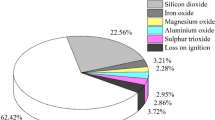Abstract
This study investigates the mechanical and thermal properties of cement mortars incorporating two types of waste slags: ferrochrome (FeCr) slag aggregate was used as a replacement for sand at ratios of 25, 50, 75 and 100 wt%, and ground granulated blast furnace slag (GGBS) was used as a partial replacement for cement at a ratio of 25 wt%. Compressive strength, volume of permeable voids (VPV), drying shrinkage, and thermal conductivity tests were conducted after 28 days of curing. The microstructure characteristics were examined by scanning electron microscopy. The experimental results revealed that FeCr waste aggregates could satisfactorily replace natural fine sand in cement mortars up to 25 wt% without a remarkable degradation of compressive strength. Furthermore, increasing the replacement ratios of FeCr aggregates by over 25 wt% resulted in a noticeable decrease in thermal conductivity and an increase in the permeable void content of cement mortars. The increased VPV of FeCr slag-blended mortars led to a significant increase in drying shrinkage. The integration of GGBS with FeCr aggregates led to enhanced compressive strength and reduced VPV and drying shrinkage, thus contributing to an improved microstructure.








Similar content being viewed by others
References
Alwaeli M, Nadziakiewicz J (2012) Recycling of scale and steel chips waste as a partial replacement of sand in concrete. Constr Build Mater 28(1):157–163
Rao GA, Prasad BR (2002) Influence of the roughness of aggregate surface on the interface bond strength. Cem Concr Res 32(2):253–257
Taha B, Nounu G (2008) Properties of concrete contains mixed colour waste recycled glass as sand and cement replacement. Constr Build Mater 22(5):713–720
Borhan TM (2012) Properties of glass concrete reinforced with short basalt fibre. Mater Des 42:265–271
Wang Q, Yan P, Yang J, Zhang B (2013) Influence of steel slag on mechanical properties and durability of concrete. Constr Build Mater 47:1414–1420
Al-Jabri KS, Hisada M, Al-Oraimi SK, Al-Saidy AH (2009) Copper slag as sand replacement for high performance concrete. Cem Concr Compos 31(7):483–488
Saha AK, Sarker PK (2017) Compressive strength of mortar containing ferronickel slag as replacement of natural sand. Procedia Eng 171:689–694
Al-Jabri KS, Shoukry H, Khalil IS, Nasir S, Hassan HF (2018) Reuse of waste ferrochrome slag in the production of mortar with improved thermal and mechanical performance. J Mater Civ Eng 30(8):04018152
Al-Jabri KS, Al-Saidy AH, Taha R (2011) Effect of copper slag as a fine aggregate on the properties of cement mortars and concrete. Constr Build Mater 25(2):933–938
Jena S, Panigrahi R (2019) Performance assessment of geopolymer concrete with partial replacement of ferrochrome slag as coarse aggregate. Constr Build Mater 220:525–537
Panda CR, Mishra KK, Panda KC, Nayak BD, Nayak BB (2013) Environmental and technical assessment of ferrochrome slag as concrete aggregate material. Constr Build Mater 49:262–271
Saha AK, Sarker PK, Majhi S (2019) Effect of elevated temperatures on concrete incorporating ferronickel slag as fine aggregate. Fire Mater 43(1):8–21
Flower DJ, Sanjayan JG (2007) Greenhouse gas emissions due to concrete manufacture. Int J Life Cycle Assess 12(5):282
Al-Jabri K, Shoukry H (2014) Use of nano-structured waste materials for improving mechanical, physical and structural properties of cement mortar. Constr Build Mater 73:636–644
Oner A, Akyuz S (2007) An experimental study on optimum usage of GGBS for the compressive strength of concrete. Cem Concr Compos 29(6):505–514
Babu KG, Kumar VSR (2000) Efficiency of GGBS in concrete. Cem Concr Res 30(7):1031–1036
Tsai CJ, Huang R, Lin WT, Wang HN (2014) Mechanical and cementitious characteristics of ground granulated blast furnace slag and basic oxygen furnace slag-blended mortar. Mater Des 60:267–273
Vardhan K, Siddique R, Goyal S (2019) Influence of marble waste as partial replacement of fine aggregates on strength and drying shrinkage of concrete. Constr Build Mater 228:116730
Alshamsi AM (1997) Microsilica and ground granulated blast furnace slag effects on hydration temperature. Cem Concr Res 27(12):1851–1859
Sikora P, Horszczaruk E, Skoczylas K, Rucinska T (2017) Thermal properties of cement mortars containing waste glass aggregate and nanosilica. Procedia Eng 196:159–166
Yousefi A, Tang W, Khavarian M, Fang C, Wang S (2020) Thermal and mechanical properties of cement mortar composite containing recycled expanded glass aggregate and nano titanium dioxide. Appl Sci 10(7):2246
Al-Jabri K, Shoukry H (2018) Influence of nano metakaolin on thermo-physical, mechanical and microstructural properties of high-volume ferrochrome slag mortar. Constr Build Mater 177:210–221
Gori F, Corasaniti S (2014) Effective thermal conductivity of composites. Int J Heat Mass Transf 77:653–661
Shoukry H, Kotkata MF, Abo-EL-Enein SA, Morsy MS, Shebl SS (2016) Thermo-physical properties of nanostructured lightweight fiber reinforced cementitious composites. Constr Build Mater 102:167–174
Duxson P, Fernández-Jiménez A, Provis JL, Lukey GC, Palomo A, van Deventer JS (2007) Geopolymer technology: the current state of the art. J Mater Sci 42(9):2917–2933
Acknowledgements
The authors would like to acknowledge the financial support provided by Sohar Port and Free Zone Company under Sultan Qaboos University Grant no. CR/ENG/CAED/18/07.
Author information
Authors and Affiliations
Corresponding author
Rights and permissions
About this article
Cite this article
Baawain, M., Shoukry, H. & Al-Jabri, K. An Investigation into the Thermo-Physical, Mechanical, and Microstructural Properties of Cement Mortar Incorporating Hybrid Waste Slags. Int J Civ Eng 19, 17–26 (2021). https://doi.org/10.1007/s40999-020-00554-z
Received:
Revised:
Accepted:
Published:
Issue Date:
DOI: https://doi.org/10.1007/s40999-020-00554-z




